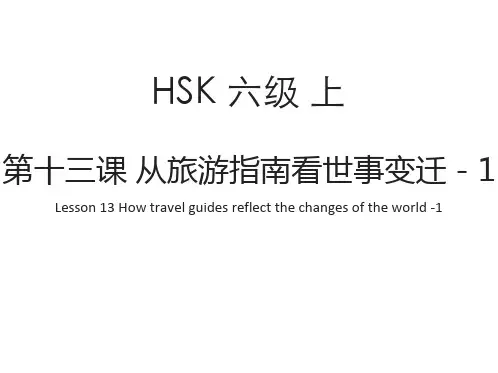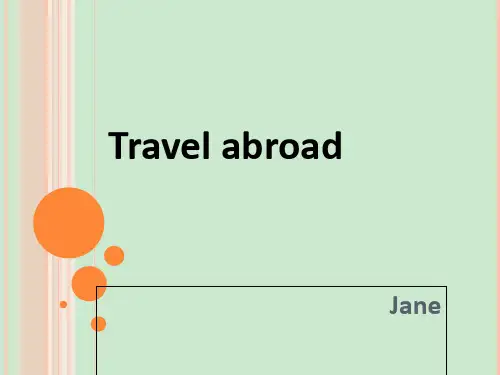发展汉语中级口语I第13课旅游课件
- 格式:ppt
- 大小:479.00 KB
- 文档页数:18

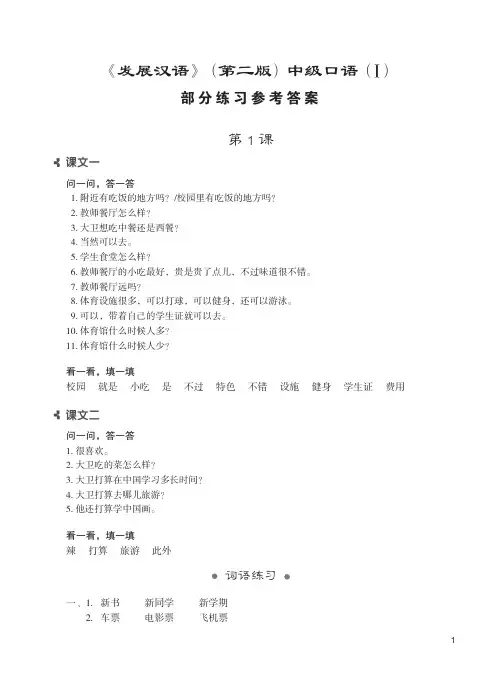
《发展汉语》(第二版)中级口语(Ⅰ)部分练习参考答案第 1 课课文一问一问,答一答1. 附近有吃饭的地方吗?/校园里有吃饭的地方吗?2. 教师餐厅怎么样?3. 大卫想吃中餐还是西餐?4. 当然可以去。
5. 学生食堂怎么样?6. 教师餐厅的小吃最好,贵是贵了点儿,不过味道很不错。
7. 教师餐厅远吗?8. 体育设施很多,可以打球,可以健身,还可以游泳。
9. 可以,带着自己的学生证就可以去。
10. 体育馆什么时候人多?11. 体育馆什么时候人少?看一看,填一填校园 就是 小吃 是 不过 特色 不错 设施 健身 学生证 费用课文二问一问,答一答1. 很喜欢。
2. 大卫吃的菜怎么样?3. 大卫打算在中国学习多长时间?4. 大卫打算去哪儿旅游?5. 他还打算学中国画。
看一看,填一填辣 打算 旅游 此外词语练习一、1. 新书 新同学 新学期2. 车票 电影票 飞机票二、1. 特色 2. 健身 3. 打算 4. 特色 5. 旅游 6. 健身 7. 特色 8. 费用9. 最好 10. 旅游 11. 健身 12. 健身 健身 13. 旅游 14. 特色15. 旅游 旅游 16. 健身 17. 打算 18. 费用 19. 打算 20. 费用第 2 课课文一问一问,答一答1. 我们怎么称呼你的家人?2. (你不是中国人,)叫错了也没什么。
3. 她们恐怕会不太高兴。
4. 什么人可以叫“老师”?5. 对有官职的人,最好称呼他们的官职。
6. 副的官职最好怎么称呼?看一看,填一填称呼 丢脸 叔叔 嘛 没什么 职业 出错 服务员 老师 不如 怪直接 反正课文二问一问,答一答1. 怎么称呼不熟悉的人?2. 能行。
不过说话的时候得注意,有的话不能说。
3. 用什么方式称呼别人是不礼貌的?看一看,填一填最好 官儿 招儿 你好 劳驾 打扰你一下 喂 哎 入乡随俗亲热 必要词语练习一、1. 洒水车 救护车 消防车2. 联系人 负责人 发言人3. 班长 组长 队长二、1. 出错 2. 打交道 3. 出错 4. 称呼 5. 不见得 6. 打交道 7. 招儿8. 不见得 9. 打交道 10. 难怪 11. 招儿 12. 难怪 13. 称呼 14. 称呼 15. 难怪 16. 招儿第 3 课课文一问一问,答一答1. 小林是哪儿的人?2. 扬州在哪儿?3. 扬州大吗?4. 扬州有四百五十万人口。


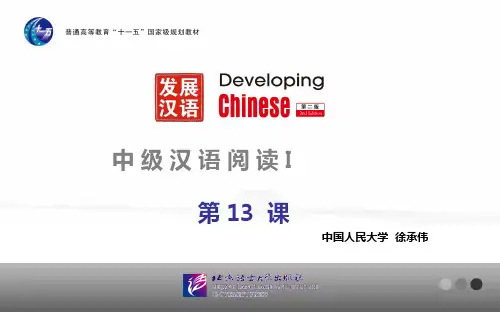
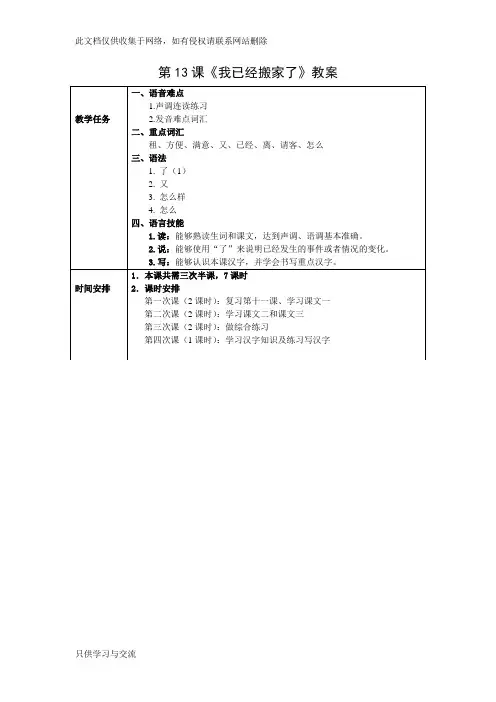
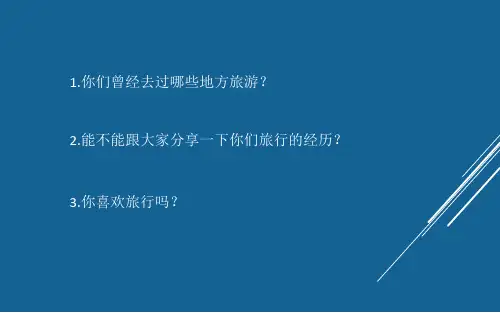
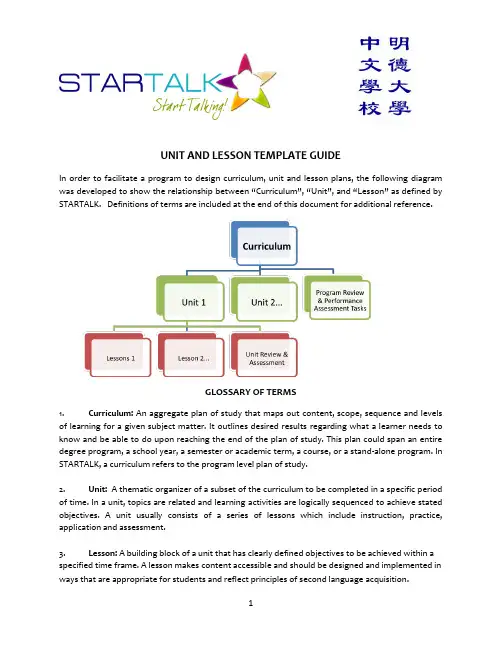
UNIT AND LESSON TEMPLATE GUIDEIn order to facilitate a program to design curriculum, unit and lesson plans, the following diagram was developed to show the relationship between “Curriculum”, “Unit”, and “Lesson” as defined by STARTALK. Definitions of terms are included at the end of this document for additional reference.GLOSSARY OF TERMS1.Curriculum: An aggregate plan of study that maps out content, scope, sequence and levels of learning for a given subject matter. It outlines desired results regarding what a learner needs to know and be able to do upon reaching the end of the plan of study. This plan could span an entire degree program, a school year, a semester or academic term, a course, or a stand-alone program. In STARTALK, a curriculum refers to the program level plan of study.2.Unit: A thematic organizer of a subset of the curriculum to be completed in a specific period of time. In a unit, topics are related and learning activities are logically sequenced to achieve stated objectives. A unit usually consists of a series of lessons which include instruction, practice, application and assessment.3.Lesson: A building block of a unit that has clearly defined objectives to be achieved within a specified time frame. A lesson makes content accessible and should be designed and implemented in ways that are appropriate for students and reflect principles of second language acquisition.DescriptionEnd of Unit Performance Tasks (How can students demonstrate what they have learned in this unit?) What culminating performance tasks will provide evidence that students have achieved thestated learning objectives? Indicate how students will be assessed for each mode ofcommunication through interpretive, interpersonal and presentational performance tasks.End of Unit St andards, The 5 “C’s” (How can students demonstrate what they have learned inaddition to Communication, i.e. Culture, Comparisons, Connections & Communities?)Outline of Unit Lessons (The number of lessons will vary according to the timeframe for the unit theme. )Week 1Week 2Week 3Week 4Week 5。
